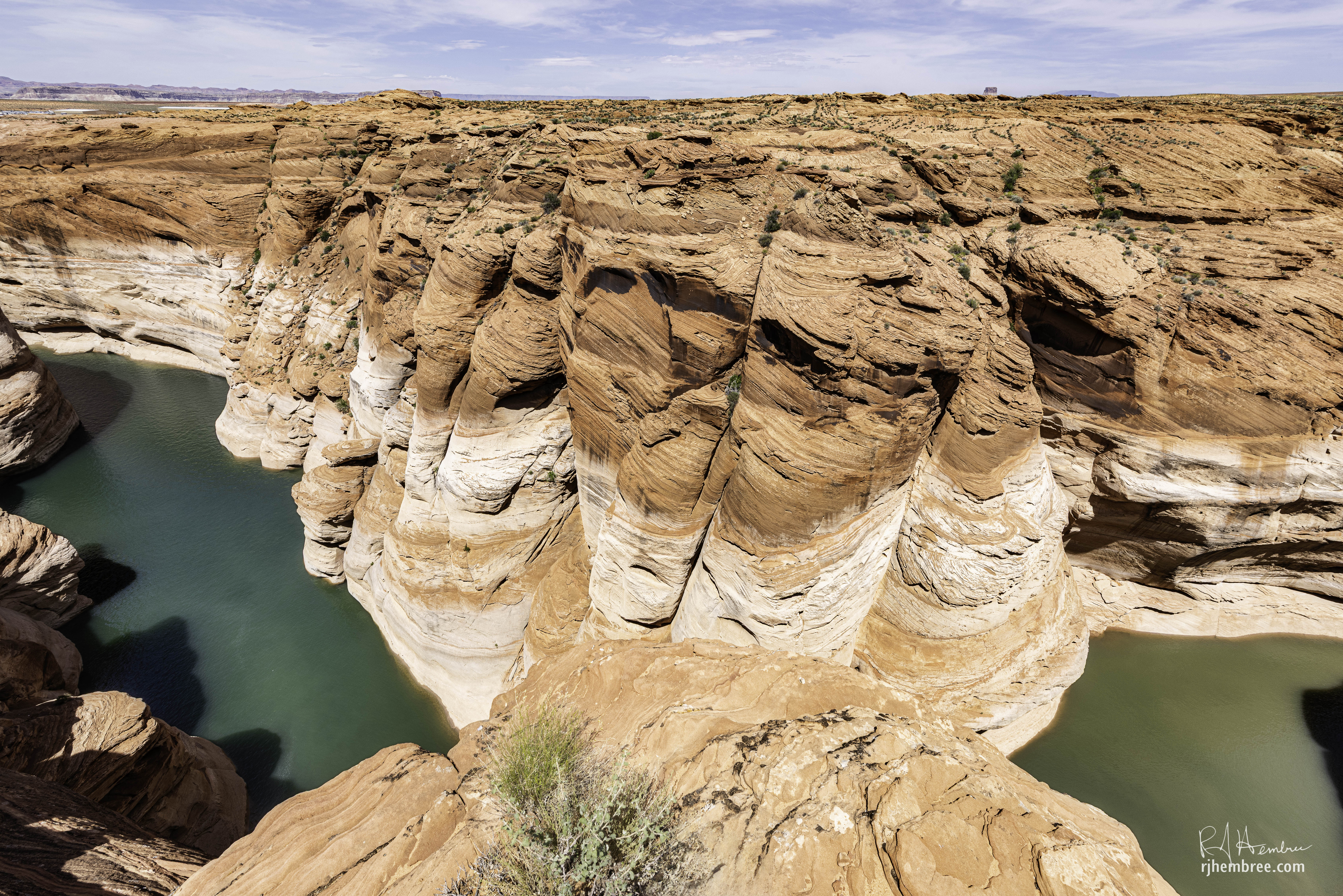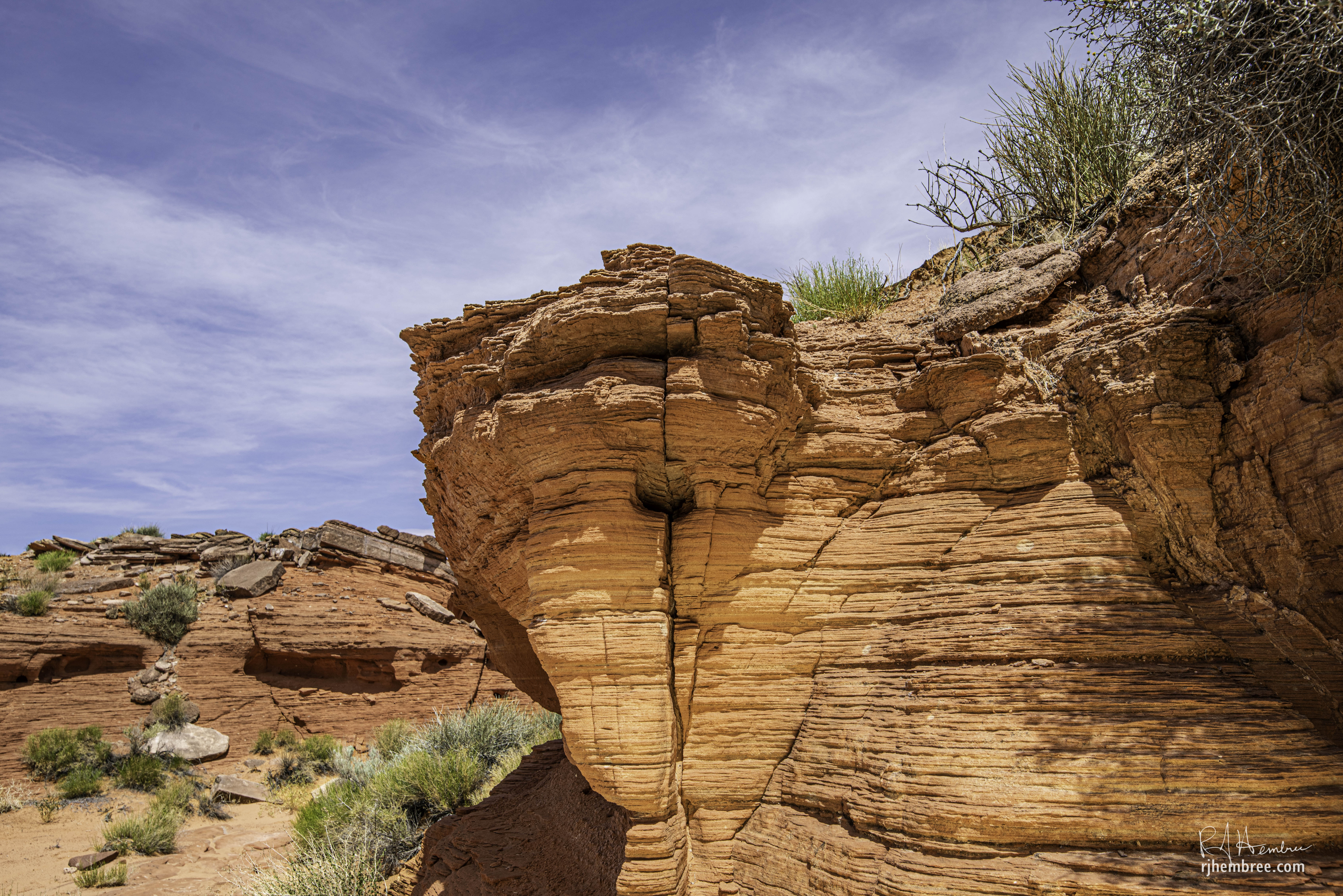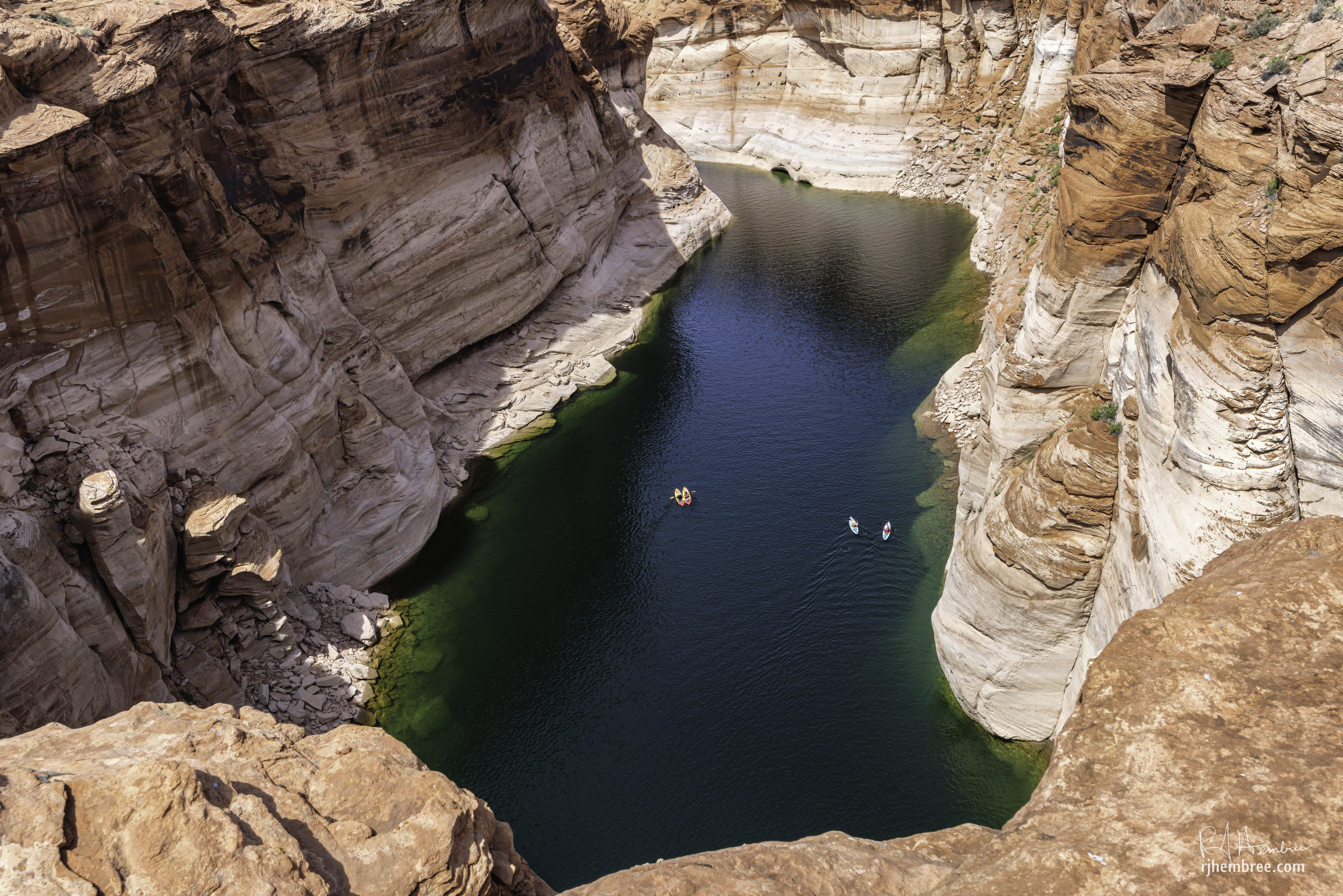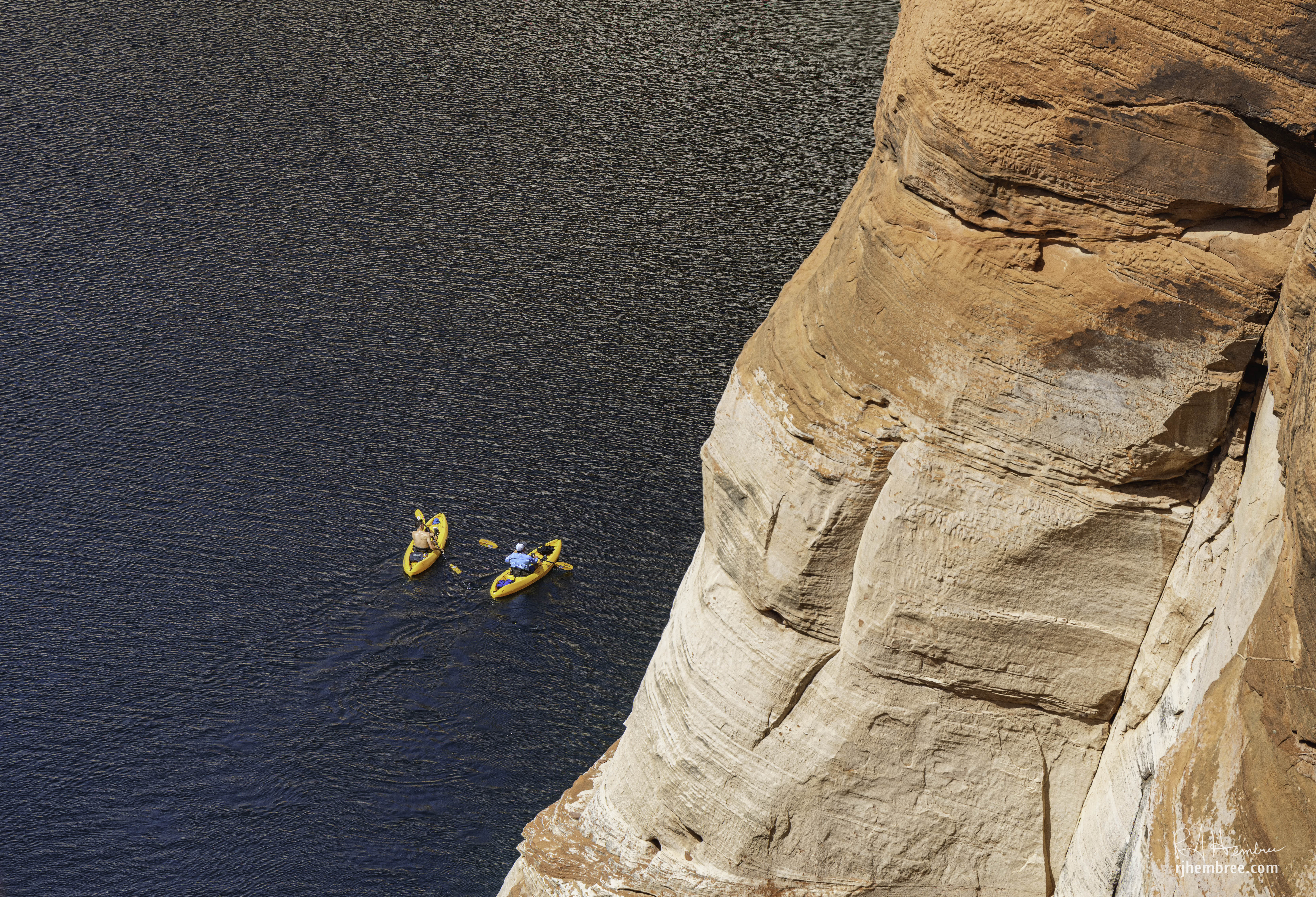Cartography of Light Under a Relentless Sun
Navigating Antelope Canyon's Rim and Underestimating the High Desert
By Bob Hembree
 Thresholds of Retirement
Thresholds of Retirement
The transition came not as cessation but as transformation, one form of motion exchanged for another. While others might imagine retirement as a slowing, a gradual receding like Lake Powell during drought years, I experienced it as acceleration. The first thing I did after retiring was go to work. Not in the conventional sense of timecards and supervisors, but in the essential work of seeing and documenting. There was a world to be seen, recorded, interpreted through lens and light. This photographer had appointments with landscapes across North America—fleeting engagements measured in days or weeks, never long enough to satisfy the eye's hunger for detail, for revelation.
I had finally arrived at that peculiar freedom where geography becomes a choice rather than an obligation. I could plant myself anywhere, with a single non-negotiable criterion: the area must offer inexhaustible photographic possibilities. The search ended quickly when I encountered Page, Arizona—a human settlement perched on Manson Mesa like a proposition, surrounded by evidence that time flows differently through stone than through flesh.
What I hadn't anticipated was the newspaper's invitation. The Lake Powell Chronicle needed a writer/photographer, and I discovered myself saying yes before fully considering the implications. This unexpected turn proved transformative—not merely employment but initiation. The position offered compressed education in local history, Navajo culture, and access to terrains absent from glossy travel publications. Through reporting on school board meetings and town developments, I gained entry to the community's inner workings. Through photographing local events, I developed understanding of the human landscape superimposed upon the geological one.
Page resides at the center of what tourism officials call the Grand Circle, a cartographer's shorthand for a region containing the highest concentration of national parks and monuments in America. Every element a photographer might desire exists within this radius: dramatic skies that transform hourly with light and cloud, terrain that alternates between yawning vastness and intimate detail, colors that shift from bloodred to ethereal blue depending on angle and hour. Most crucially, these wonders remain accessible—by vehicle when necessary, by bike when possible, by foot when essential.
I soon established a pattern of multiple homes: the physical residence in Page, the mobile studio of my camera bag, and the constellation of locations that became my true dwelling places—Horseshoe Bend at first light, Lake Powell at sunset, the less-traveled edges of canyons where solitude allows for deeper conversation with stone and sky. These places, rather than the house where I stored my equipment, became the actual geography of my retirement.
 Preparing for Pilgrimage
Preparing for Pilgrimage
My most frequent journeys begin as responses to light. I look outside, evaluate cloud patterns and atmospheric conditions, and make instantaneous calculations about potential. On promising mornings, I gather equipment with practiced movements—each lens selection a hypothesis about what might appear, each filter an acknowledgment of light's complexities. I've learned that Page offers three or four evenings weekly when conditions align for dramatic skies—when clouds arrive in optimal formations to catch sunset's palette, when humidity levels create ideal atmospheric conditions for light's transformation.
Occasionally I venture beyond familiar circuits, drawn toward unconventional perspectives of iconic locations. This impulse led me toward the rimside view of Antelope Canyon—a vantage point rarely captured, offering counterpoint to the thousands of photographs taken daily from within the slot canyon's sinuous interior.
Preparation for such journeys involves multiple cartographies. First comes the physical reconnaissance—taking vehicle or bicycle to access points, scanning visible terrain for potential pathways and obstacles. Later, at home, I translate these observations onto Google Earth's digital elevation models, tracing hypothetical routes with my finger on the screen like a pilgrim planning a devotional journey. The satellite imagery reveals ravines and ridgelines invisible from ground level, but I've learned that even the most sophisticated mapping cannot disclose certain ground-truths—the stability of particular rock formations, the steepness of certain descents, the presence of wildlife.
I never commit absolutely to predetermined routes. Experience has taught the value of adaptation, of responding to what emerges rather than imposing expectations. The terrain maps identify washes and cliff faces, but not the unexpected beauty that might necessitate deviation. This methodical yet flexible preparation characterized my approach to exploring Antelope Canyon's upper rim—a perspective seldom seen by tourists focused on the slot canyon's interior light shows.
 Descent into Light
Descent into Light
Sunday, May 17, 2020, arrived with meteorological promise: forecast high of 90 degrees, 6 percent humidity, 50 percent cloud cover. For photographers, such numbers translate into potential for dramatic contrast and saturated color. Deep canyons with north-south orientation present specific challenges for photography—light enters only during limited windows, requiring precise timing. My intended position on the western rim meant early afternoon would offer optimal conditions, when sunlight would directly illuminate the eastern cliff faces and water below.
The fundamental truth of photography—that cameras record only light, not objects—guided my timing calculations. I wasn't documenting a canyon but tracking the interaction between photons and sandstone, between direct illumination and reflected color. This understanding transformed the hike from mere locomotion into temporal navigation, a journey coordinated with the sun's arc.
My backpack contained the essentials for both survival and photography: two bottles of cold water, a small ice pack, and nutritional insurance in the form of an Atkins shake. The optical equipment included a Nikon D810, graduated neutral density filters to balance exposure between bright sky and shadowed canyon, and two lenses offering different perspectives on what might appear—the Tamron 15-30mm for expansive context, the Tamron SP 70-200mm for isolating details across the canyon's width.
As I began the three-mile descent down Manson Mesa's side around 11 a.m., the first discrepancy between forecast and reality emerged. The promised cloud cover—that photographer's diffusion panel stretching across the sky—was conspicuously absent. In high desert at midday, this absence transforms a pleasant hike into a negotiation with heat. I found myself hoping for clouds not merely as photographic elements but as welcome protection from the sun.
The journey downward offered unexpected compensations. A ravine provided temporary sanctuary—not merely from sun but for careful composition. The contrast between jagged foreground formations and the distant silhouettes of Tower Butte and Navajo Mountain created natural composition, the vast intervening space serving as counterpoint to solid form. Wind and water had sculptured shallow caves into the sandstone, their curving interiors housing communities of antlions. Their conical traps pockmarked the fine sand like miniature impact craters—evidence of predatory patience in a landscape that rewards nothing less.
Continuing toward the canyon required careful reading of the stone beneath my feet. Desert hiking teaches discrimination between surface appearances and structural reality. Some rock formations display convincing solidity while harboring internal fractures that give way under human weight. On steep terrain with no cell service, such misreadings can transform photography expedition into survival ordeal.
 Revelation at the Rim
Revelation at the Rim
The moment of arrival at the canyon's edge induced involuntary smile—that physical manifestation of wonder when expectations surrender to actuality. Below, hundreds of feet down vertical cliffs, Antelope Canyon's water passage opened toward Lake Powell. Several kayakers navigated the channel, their colorful crafts providing scale against monumental stone. A solitary figure on an electric surfboard glided across the water's surface, all of them unaware of the photographer positioned above like some benevolent surveillance system.
I positioned the tripod at multiple points along the rim, testing different focal lengths and exposure settings, each combination offering different interpretations of the same reality. The canyon walls contained chapters of geological history written in sedimentary layers and erosion patterns. The 15-30mm lens captured contextual vastness; the 70-200mm isolated details within the larger story—textural elements, color variations, the abstract compositions created where shadow met illumination on striated surfaces.
Swallows traversed the canyon's width, their teal wings catching sunlight like metallic flashes. The 200mm reach proved insufficient for capturing their details, prompting momentary consideration of returning with heavier equipment before physical reality reasserted itself. The prospect of carrying a 600mm lens up a thousand-foot elevation gain offered potent reminder of photography's material constraints. Every equipment choice represents negotiation between visual possibility and physical limitation—pounds accumulate exponentially during ascent.
Words inevitably falter when attempting to translate visual experience. Photographs themselves offer more accurate transcription, yet even they capture only partial aspects of multisensory immersion. The heat radiating from stone, the absolute silence between wind gusts, the disorienting scale relationships between human body and geological formation—these elements resist both verbal and visual documentation.
 Ascent Through Transformation
Ascent Through Transformation
The promised clouds never materialized. The water bottle at my hip had transformed from refreshment to tepid disappointment, while the uphill return journey stretched before me like an unwelcome transformation—from observer to participant in heat's experiments. I recognized the ascent would require more frequent rest intervals, and made strategic decision to position these breaks at photographically promising locations. This necessity became opportunity—while recovering breath, I could explore different perspectives.
Though my primary intent involved wide-angle landscape composition, the ground itself offered unexpected portfolio of abstract possibilities. The scattered geological confetti—fragments of varied minerals and rock types—presented compositions rivaling deliberate artistic arrangement. The photography wasn't merely about documenting what appeared but developing the ability to recognize order and meaning within apparent randomness. These small-scale compositions offered counterpoint to the canyon's monumentality—intimate details alongside sweeping vistas.
My return path diverged from the descent route, curiosity overriding efficiency as I explored Manson Mesa's eastern cliffs. These surfaces had transitioned into shadow by my arrival, offering cooler temperatures but requiring photographic adaptation to reduced light. The backpack seemed to gain mass with each ascending step, its weight no longer distributed across eager anticipation but concentrated on present exertion.
The last water bottle surrendered its contents in carefully rationed sips. The once-frozen ice pack had completed its phase transition, offering minimal relief. Heat and aridity conspired to extract moisture from my body in seemingly exponential progression. The exhilaration of discovery that characterized the descent had transformed into determined endurance.
The return journey extended three times longer than the outward path, not merely from physical depletion but from route-finding challenges. The alternative path presented recurring decision points—whether to attempt direct ascent up rock faces or circumnavigate via gentler gradient. A ten-foot climb in shade often proved more appealing than half-mile detour through direct sun. Earlier observations about deceptive stability in gray sandstone informed each evaluation, creating mental map of avoidance zones.
An unexpected encounter across a ravine—one of the area's substantial gray coyotes occupying my intended path—introduced additional variable. We conducted mutual assessment through sustained eye contact before continuing separate journeys, though heightened vigilance accompanied my remaining mile.
The transition from wilderness to pavement should have signaled conclusion, but body systems had begun registering objections to the day's demands. With home merely two blocks distant, my right leg announced crisis through comprehensive cramping from hip to toe. I found myself seated on a curb, confronting possibility that heat exhaustion had progressed toward more serious condition.
Salvation arrived through community connection—a neighbor with emergency medical training recognizing distress from across the street. His intervention—cold water, improvised cooling through iced towel around neck, manipulation of knotted muscle—provided necessary bridge between wilderness experience and domestic return. After twenty minutes of focused attention, minimal function was restored, enabling the final stretch home.
 The Cartography of Experience
The Cartography of Experience
This expedition—ambitious for a 67-year-old man whose self-concept remains suspended in perpetual 30—offered lessons beyond photographic opportunity. The images captured that day contain invisible metadata: the physical cost of their acquisition, the calculated risks, the unexpected interventions.
Would I undertake this journey again? Without question. The photographs represent not merely documentation but earned relationship with place—images whose creation required physical investment alongside technical knowledge. Would I approach differently? Certainly—with increased water supply and reduced equipment load. The high desert demands respect through proper preparation; four water bottles represent appropriate tribute where two proved insufficient.
The original plan included two potential routes, and I had selected the longer option anticipating greater photographic yield. Future expeditions would prioritize the alternate path, reducing hiking distance by two miles without sacrificing the essential destination. This wouldn't eliminate what I've come to call "the longest mile"—that final stretch where accumulated fatigue transforms ordinary distance into extraordinary challenge—but would reduce its predecessors.
What remains most vivid isn't merely the resulting photographs but the complete experience of creating them—the quality of attention photography demands, the physical interaction with landscape, the unexpected discoveries along unplanned detours. The camera serves not merely as a recording device but as a tool for connection, transforming casual looking into deliberate seeing.
The retirement I envisioned—traveling North America capturing iconic vistas—has evolved into something more specific and profound: deep immersion in a single region's inexhaustible variations. Page offers not merely convenient base for photographic expeditions but continuous education in the relationship between light and landscape, between human perception and geological process. Each journey from my doorstep—whether measured in blocks or miles—presents opportunity to witness the ongoing conversation between ephemeral conditions and ancient stone.
The photographer's true work involves not merely collecting images but developing capacity to recognize significance in ordinary light, to discriminate between momentary appearance and essential character, to translate four-dimensional experience into two-dimensional representation that somehow communicates more than its physical constraints would suggest possible. This discipline requires physical presence, technical precision, and perpetual willingness to revise expectations when encountering reality's stubborn insistence on being itself rather than our projection.
The longest mile teaches humility before both landscape and personal limitation, a lesson worth occasional relearning, even at the cost of temporary discomfort. The resulting photographs contain this knowledge as invisible element alongside composition and exposure, transforming documentation into testimony.
